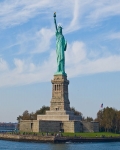Statue of Liberty
Archaeology »
Archaeological Monuments » Statue of Liberty
Statue of Liberty - United States
Statue of Liberty is located in Liberty Island,New York.
Statue of Liberty monument was established on 1924.
Primary threats to Statue of Liberty :
Statue of Liberty is one of the most recognizable icons of the United States and was, from 1886 until the jet age.
Historical facts of Statue of Liberty :
- Introduction :
The Statue of Liberty stands as a symbol of freedom, hope, and the enduring spirit of the United States. A gift from the people of France, this colossal statue has become an iconic representation not only of New York City but of the nation as a whole. In this essay, we explore the historical facts surrounding the Statue of Liberty, from its conception to its enduring significance in the hearts of millions.
- Conception and Purpose :
The idea for the Statue of Liberty can be traced back to the early 1860s when French political thinker and abolitionist Édouard René de Laboulaye proposed the notion of commemorating the alliance between France and the United States during the American Revolution. In a time of great social and political changes, Laboulaye envisioned a colossal monument that would embody the ideals of liberty, democracy, and the shared pursuit of freedom.
- The renowned sculptor Frédéric Auguste Bartholdi was entrusted with the design and construction of the statue. He envisioned a grand neoclassical figure of a woman holding a torch high above her head, symbolizing enlightenment and guiding light. The figure was to be named "Liberty Enlightening the World," a representation of the United States' commitment to freedom and its role as a beacon of hope for the oppressed.
- Fundraising and Construction :
While Bartholdi designed the statue, the pedestal on which it would stand became a collaborative effort between France and the United States. Fundraising for the construction of the pedestal proved challenging, and it was not until Joseph Pulitzer, publisher of the New York World newspaper, initiated a public campaign that the necessary funds were raised. This grassroots effort garnered widespread support from Americans, who saw the statue as a testament to their commitment to freedom and democracy.
- The statue was constructed in France and then disassembled into 350 individual pieces for transportation to the United States. It arrived in New York Harbor in June 1885, and skilled workers reassembled it on Bedloe's Island (now Liberty Island) over the course of a year. On October 28, 1886, President Grover Cleveland presided over the dedication ceremony, officially presenting the Statue of Liberty to the United States as a gift from France.
- Symbolism and Features :
The Statue of Liberty's symbolism is deeply ingrained in its design and features. Standing at a towering height of over 305 feet, the statue is made of copper sheets, which have oxidized over time, giving it the distinct green patina it possesses today. Lady Liberty holds a torch in her right hand, representing progress and enlightenment, while her left hand clasps a tablet inscribed with the date of the American Declaration of Independence, July 4, 1776.
- At her feet lies a broken chain, symbolizing the emancipation of slaves and the abolition of slavery. This profound representation highlights the Statue of Liberty's resonance with the struggle for civil rights and freedom throughout history.
- Historical Significance :
The Statue of Liberty quickly became a symbol of hope for immigrants arriving in America seeking a better life. As a prominent fixture at the entrance to New York Harbor, it greeted millions of immigrants who passed by Ellis Island on their way to the United States between 1892 and 1954. For many, Lady Liberty was their first sight of the new land they would call home, symbolizing the promise of freedom and opportunity.
- During the late 19th and early 20th centuries, the statue's significance grew as it became an integral part of American culture and identity. It represented the ideals that the nation was built upon and stood as a reminder of the responsibility to protect and uphold the principles of liberty and justice for all.
- Conclusion :
The Statue of Liberty's historical significance transcends its physical presence. It stands as a timeless reminder of the enduring values of freedom, democracy, and hope. From its inception as a gesture of friendship between France and the United States to becoming a beacon of hope for immigrants and a symbol of American resilience, the Statue of Liberty continues to inspire and unite people from all walks of life. As a cherished icon, it reminds us of the importance of upholding the principles it represents and serves as a testament to the power of liberty and the pursuit of a better future for all.

